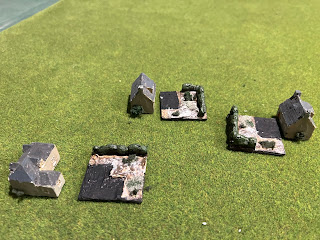I've been reading a bit recently about the Dardanelles campaign of 1915, and the 'Gallipoli' landings. Not exactly a campaign in which allied commanders covered themselves in glory, and a campaign in which Turkish commanders mostly did. One of the wargames obstacles I have faced, particularly with the Anzac landings, is the complexity of the terrain and how to model it on the wargames table. I have also pondered how you could model the path of the battle at Anzac with the hindsight of our historical knowledge, and the very small force of Turkish troops immediately available for the defence. How did you stop this assault with such small defending forces?
 |
| Source: https://heritage.hamiltonlibraries.co.nz/objects/5154/landing-at-gallipoli |
I had a fresh read of Shawn and Robert's scenario book 'Our sons as well', featuring the battles on the peninsular. There were several specific rules amendments in particular that caught my attention, and led me to give this a try:
- The landing rules, that in particular slow the speed of progress off the beach. HQs cannot move off the beach without an order change, the roll being reduced because of the relative remoteness of the higher level command elements out to sea, and
- Troops can only land if there is room for them on the beach front, otherwise they must wait another turn, and the length of beach on which they can land is limited, and
- The reduction in speed (half speed) for elements crossing contours, to reflect the relative difficulty of the terrain facing the Australians and New Zealanders.
I used every single contour piece I had in my terrain collection, and even then wasn't able to model the four contour levels that the terrain warrants.
 |
| The first Australian brigade starts to land, not all there yet |
 |
| Defending Turkish gun battery |
 |
| Defending platoon at Fisherman's Hut |
 |
| The forward defending Turkish company, which became an early casualty |
 |
| Flank fire on the attackers |
 |
| Australian infantry move off the beach |
 |
| By turn 5, one Turkish company has been eliminated, along with four Australian companies |
 |
| Turn 6 and another Australian Brigade is landing. The Turkish defenders from Gaba Tepe on the right of the beaches have moved onto the flank of the attackers (right edge of the photo) |
 |
| The attackers are beginning to get strung out by the terrain |
 |
| Having been held up in front of the defending Turkish company, and gun battery, I decide to push the bulk of the attackers on past them. Sari Bair beckons. The attackers are held up by the failure to roll high enough for the orders changes for HQ.. this rules mechanism works well in reducing the attackers' flexibility, and speed of advance. It's all about timing ... |
 |
| The leading attackers now well out ahead |
 |
| Move 8 and the degree of attacker disorganisation is becoming evident |
 |
| And still the attackers race for the inland heights |
 |
| Still the Turkish gun battery holds out, albeit suppressed at this stage.. it actually survived the whole 10 turns I played |
 |
| Pressure on the attackers' right from the troops that have advanced from Gaba Tepe |
 |
Move 10 and the first Turkish reinforcements arrive .. most of a Turkish regiment, top left of the photo
|
 |
| Turkish reinforcements .. and under strength regiment |
 |
| The view from behind the Turkish reinforcements |
I stopped at this stage. This was a solo run through of the attack. I was interested in if or how this would play out, as on paper I had the impression that it was a damned hard ask for the Turkish defenders to keep the attackers at bay. By move 10 the leading Australian Brigade was approaching a morale check, with not quite 50% casualties, and was already facing a fresh Turkish regiment, with another regiment only two moves away.
As I suspected, the limitation to the attackers' ability to get off the beach created by the rules addition that requires an HQ to sit on the beach until it rolls a successful order change, the normal existence of a command radius for all units pert the standard rules, and the impact on movement of crossing contours coupled with the complexity of the terrain with ridges and valleys, has a profound impact on the attack. That is the intention. I initially sat thinking I'd shoot it out in a firefight with the few defenders, and then being conscious of the impending arrival of Turkish reinforcements, decided to rush forward and grab as much high ground as I could, meant the attack became disorganised.
Sounds realistic to me...
Now I was loose with the rules, as one may be when solo 'gaming something (are you?), and so the rigour of a 'live opponent' might well change things. However my overall sense is that this is a fascinating wargame, much much more than a simple historical recreation for visual effect. Both sides can win.. that's a win!!!
The game was fought using my 6mm armies, created using miniatures from Irregular Miniatures. The boats signifying the landing are also from Irregular. I showed them in more detail here.
You can see Robert's Gallipoli demo game here.










































